5 Days in Lisbon: Travel Itinerary and Coastal Day Trips
Lisbon had been on my to-do list for a long time, and certainly I did not regret visiting! The Portuguese capital and its surrounding offer a fantastic mix of culture, landscapes, food, and cute stores – ideal to spend a few days there. My focus on this trip was to get a taste not only on the city, but also get to know its surroundings. Explore this 5 days in Lisbon guide to get ideas for your trip!

Day 1 – Discovering Lisbon
Belém Tower
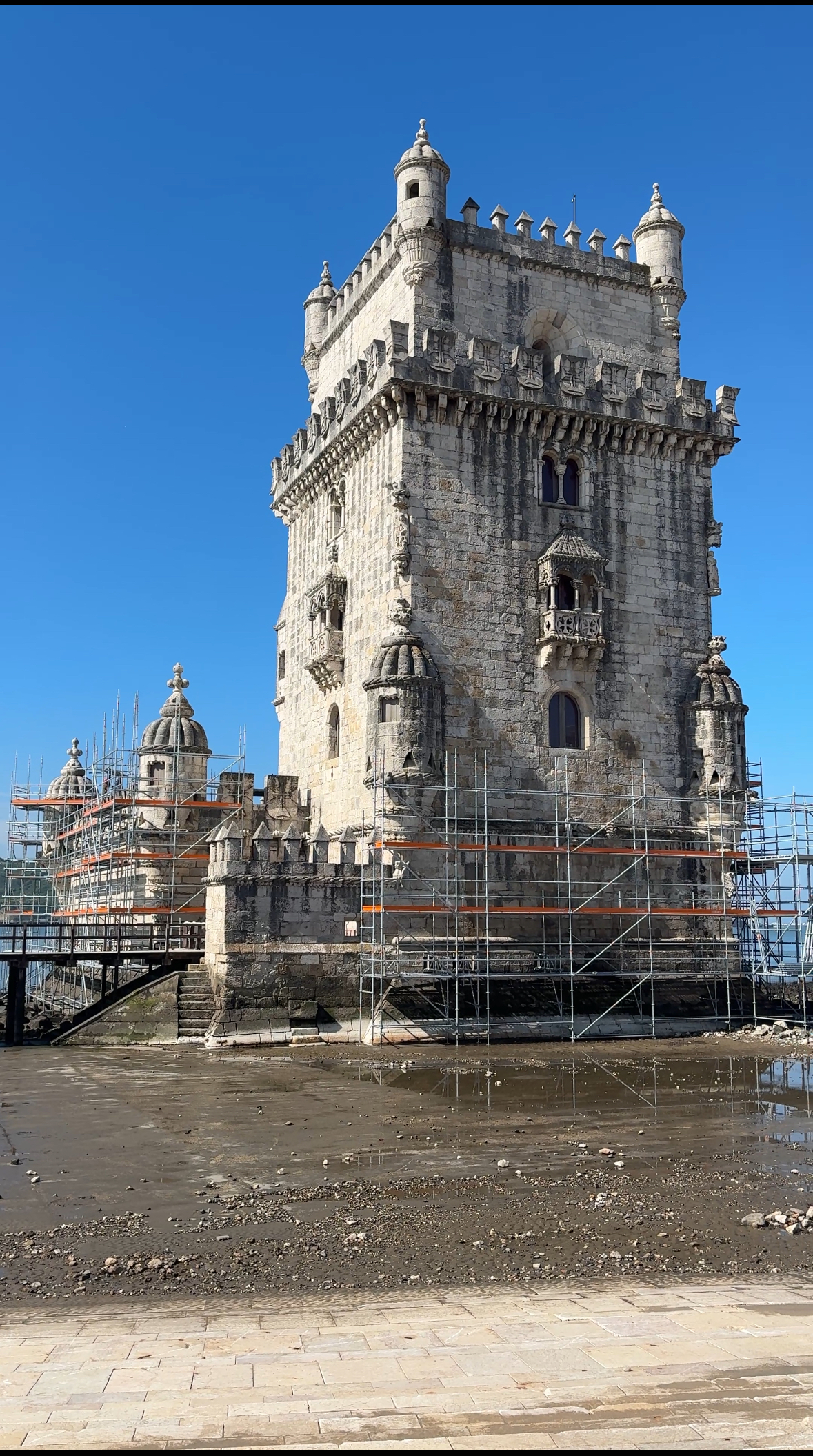
While my hotel was in Caparica, I decided to go to Lisbon first. I only had one day to see the capital, so I was determined to get the most out of it. The first stop was the Belém Tower, the iconic 16th-century fortress that once guarded the city’s harbor. I had taken a Bolt to come to Lisbon, and while I left relatively early, with the extreme traffic, I ended up arriving at around 10.
Lisbon is a very touristic place: already vising at the end of May, the place was crowded, with multiple buses bringing in tourists. As per May 2025, the tower is under restauration, so access inside is not allowed. Additionally, the structure was covered in scaffolding, which subtracted from the experience. However, monuments must be maintained so that future generations can enjoy them too, so while disappointing personally, I cannot but support the work it takes to keep out heritage nice and shiny.
Padrão dos Descobrimentos
Since the Belém Tower was being renovated, I didn’t stay there long. On the same street, heading back direction towards the city, there is the Padrão dos Descobrimentos. This monument was built to honor the Age of Exploration of Portugal from the 15th and 16th centuries. The monument is a 10-15 min walk from the Belém Tower.
Beware that you cannot walk straight to the monument – there is a part where the ships may come in. That ramp is also used for touristic hybrid buses to come from land to water, which is fun to see. Otherwise, it’s still an easy and nice walk, it’s just that cars are a bit closer in some areas. The monument is nice, but that’s all there is to see.

Jerónimos Monastery
From there, I strolled to the Jerónimos Monastery, a masterpiece of Gothic Manueline architecture and a UNESCO heritage site since 1983 (together with the Belém Tower). Now, if you want to go in, be ready for a long line. I started queuing at around 10:30 and couldn’t get in until 12:30. The tickets are limited to just morning and afternoon options, but I believe more specific time slots would be helpful.
Waiting 2h in the Portuguese heat was a rather unpleasant experience. There is no shade, but you can buy fresh water from the street vendors. If you decide to go in the monastery, be aware of that. Also, bring sunscreen, a hat or a scarf to cover yourself from the sun, and plenty of water. Is the 2h wait worth it for what you see inside? That obviously depends on what you like. I did enjoy the interior and I appreciate the amount of people they let in at a time. Inside the monastery, I had plenty of space and time to visit the cloister at my pace.
The interior is beautiful. The is an inner garden where you’re not allowed to step in, so you’re walking around the cloister. There were also a few rooms that you could visit. If you wanted to visit the church part, you had to get out of the monastery and enter another queue. This line is shorter, and you don’t need to pay a ticket for it. The church, especially the altar part, was also under maintenance. The main sight in the church are the tombs of Vasco da Gama and Luís de Camões.






Lisbon center
After visiting this area, I went to the city center for more sights. I explored the Time Out Market, with many different restaurants. For lunch, I headed to the restaurant Anyonia Petiscos Portuguese, a small restautant, where I had an amazing octopus with veggies.
Back to the city center, I explored the Praça do Comércio, and walked around the main streets. I also checked the Elevador de Santa Justa, but did not go up using the elevator. You can actually access the views if you come from the Museu Arqueológico do Carmo. There is even a bar, Topo Chiado, from where you can sit and enjoy the views!
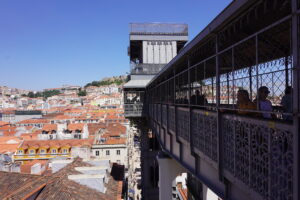

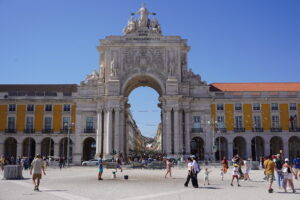
My next mission in the city was getting the famous pastel de nata from Manteigaria. Absolutely delicious, although there might be a line! I then headed up towards Livraria Bertrand, the oldest still functioning bookstore. If you buy a book there, you can get it stamped. Although most of the selection was in Portuguese, there were a few novels in English and Spanish.
Day 2 – Beaches
Enjoy Caparica
Day two was a bit eclectic, as I coordinated with some friends. In the morning, I went to Praia do Paraíso, part of the Costa da Caparica and located right in front of my hotel. It was still rather early morning, with the sun just warming me up, and a pleasant amount of people on the beach. The tide was low, forming puddles on the sand. My favorite part of Caparica is that the parking nearby the coast was only 0.5€/day. Yes, that’s not a typo. This is probably the cheapest parking I’ve seen in a long time.

Santuário de Cristo Rei
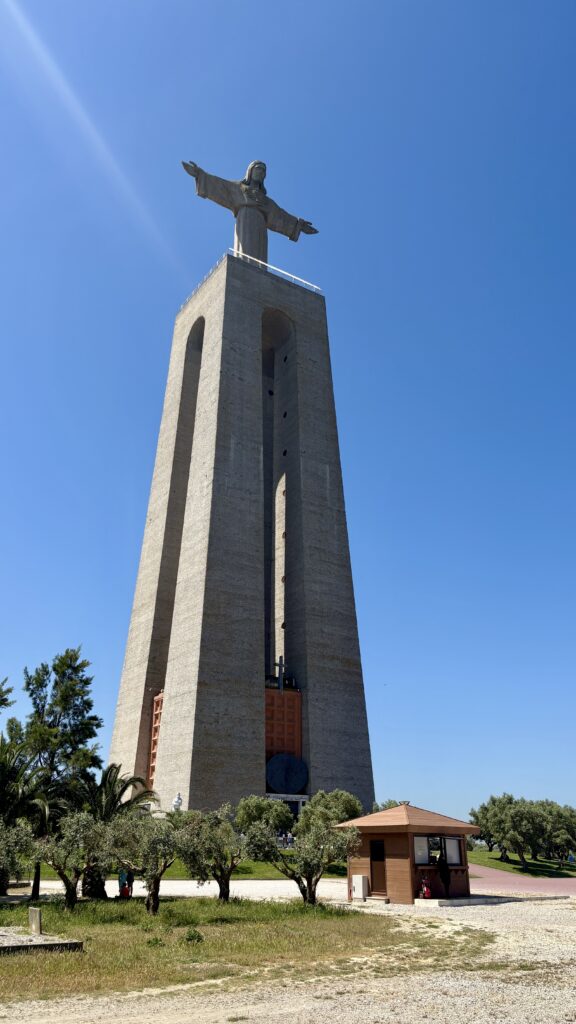
From there, I drove to the towering Santuário de Cristo Rei, where the views of Lisbon from across the river are absolutely breathtaking. I must admit that the Ponte 25 de Abril reminds me of the Golden Gate – the same red colors, shapes, and a beautiful backdrop of the city.
The sculpture of Jesus Christ was really tall. It is possible to go to the top, but I opted against it, as I didn’t think it would improve the views.
Praia do Ribeira do Cavalo
In the afternoon, I met with my friends and we headed south to Sesimbra for a bit of adventure. We wanted to explore part of the Arrábida Natural Park, and after some iterations decided to go to the Praia do Ribeiro do Cavalo.
To reach the beach, you can take a boat from Sesimbra, or you can hike. Boats are only available at certain times of the day, usually morning, so by the time we arrived there wasn’t any available – hiking was the only option. The duration of the hike depends on where you start from. If you come from the official parking lot near the Sesimbra port, the hike likely takes around 40 min. The first part is just an uphill dirt road. You can actually do this part by car, and if you get a spot, park right next to the trailhead. You will cross an open barrier mentioning that you’re in private property, and once there, just follow the trail. There are not many indications on how to reach the beach, but it’s rather self-explanatory – just head heading down or follow the people.
How was the hike there?
According to my apple watch, we did that in 23 min and it was 800 m until reaching the beach. Now, the hike is not technically easy: the soil is not solid but quite sandy and slippery, and some areas have a sharp descent. I recommend wearing appropriate shoes and plenty of water as it gets hot. However, all of this is worth when you see the beach: turquoise water, dramatic cliffs, and rocks bathed by the water. It is a popular beach, so there was plenty of people there, sunbathing and playing games. The water was calm, so it was possible to swim. The hike back was easier than down, although we got a bit lost in the trails and ended up doing a longer route to the same place.

We returned to Caparica and had dinner at Sentido do Mar, a restaurant facing the ocean, with a beautiful sunset, and delicious fish dishes.
Day 3 – Palácio de Monserrate and Quinta da Regaleira
Sintra is a popular destination, and once you’re there you can understand why. I had looked at tickets for the palaces around two weeks before leaving. The most popular ones (Palacio de Pena and Quinta da Regaleira) were already booked out for some of the time slots, so try to book those early if you have time constraints. The rest of the palaces that we saw had tickets for the same day. However, we went end of May, which is still not peak season, so this may not be the case during the most crowded summer months. My impression was that the most popular times were the morning slots, as it’s the time when the buses from Lisbon come in.
Palácio de Monserrate
Since we were staying at Quinta dos Lobos Hotel, we decided to walk to the Palácio de Monserrate. While the road didn’t seem long, only around 45 min, it was not necessarily the most pleasant route, as we were sharing the road with cars. There was some nice stops, however, with multiple quintas on the way. The palace of Monserrate definitely caused a great impression. You enter through the gardens, which have several viewpoints: the fern valley, the Japanese, rose, and Mexican gardens, a roman and Indian arches, and the scented path are some of the hallmarks one can see in the gardens. One of my favorites was the old chapel, which is a building in ruins, with many trees growing inside and around it. It gives a mystical impression, with the walls of the building raising among the lush trees.
The palace itself is beautiful. The current palace was built in the 19th century and is an example of romantic architecture. The building has a long corridor designed with Arabic influences, with multiple rooms. The most impressive is the main hall, that has an awe-inspiring ceiling. The palace of Monserrate entered the UNESCO list in 1995 and was only opened to the publicum in 2010. Our visit lasted about 2 h.

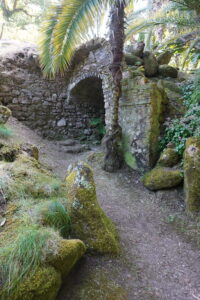
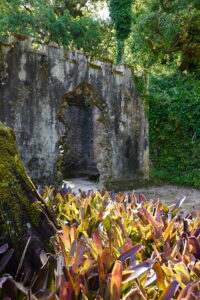
The palace is a bit isolated, so while there is a cafeteria inside, the options are limited. Getting back to Sintra is the best option. Apart from walking, the palace can be also reached by car (there is parking lot in front of it) and by bus.
Quinta da Regaleira
In the afternoon, we explored the mystical Quinta da Regaleira. The ticket entry is only valid from the time stated until 30 min later (e.g., if your ticket is at 12, you need to enter between 12 and 12:29). We arrived earlier, so we had to wait in the line, which was not great as there was no shade. One of the employees of the park was collecting signatures to ask management to add benches and shade to the waiting area, which I hope she succeeds in.
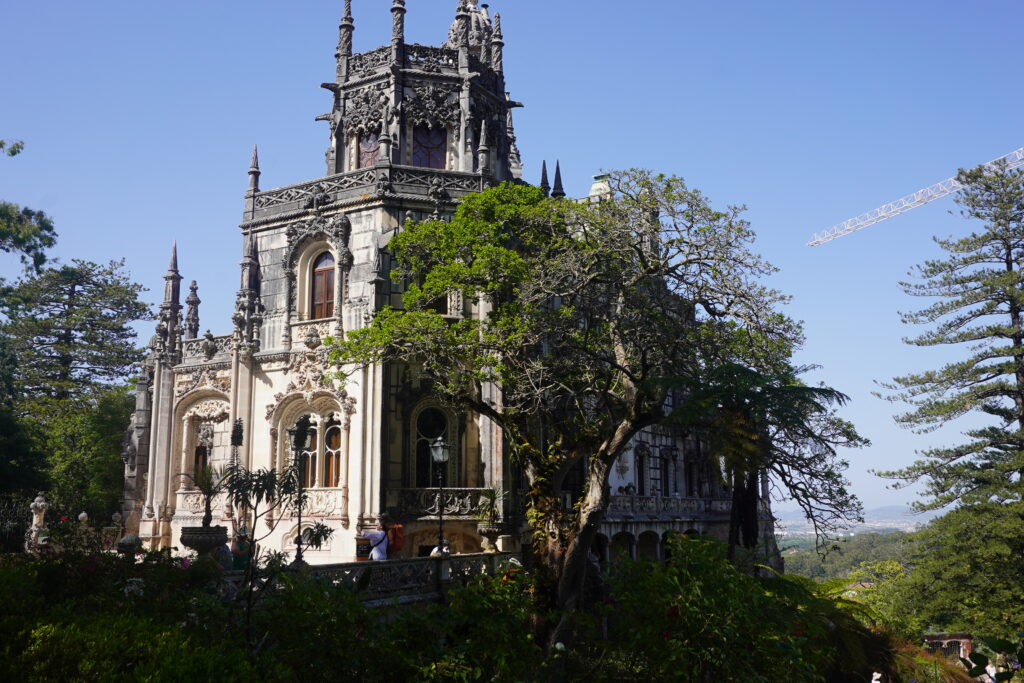


The main building of the Quinta da Regaleira was in my opinion less impressive than the palace of Monserrate, but the gardens were definitely something else. Between the secret tunnels, towers, and the famous Initiation Well, it felt like stepping into a dream. The gardens are quite large, so count for 2-3h to visit everything.
Day 4 – Wild Coastlines and Palácio da Pena
Cabo da Roca
In order to avoid an overdose of palaces, we started the day at Cabo da Roca, the westernmost point of continental Europe, where cliffs drop dramatically into the Atlantic. We had the idea of coming early in the morning to beat the crowds. Well, that did not work as expected. You see, sometimes, because of the difference in temperature between land and ocean water, especially in the summer, a thick fog may appear. It’s really famous in San Francisco, where it even has its own name, but it’s a thing in Portugal too. So when we arrived, there was almost no one else, but there was also a thick fog covering all the landscape and a strong cold wind. Despite our efforts of seeing something, that did not work.
Azenhas do Mar
Seeing that this was not going to be something resolved in the next few hours, we headed towards Azenhas do Mar, a beautiful coastal town built on a cliff. Surprisingly, the fog there was much lighter, and we could enjoy the fantastic landscapes offered.
There is a viewpoint parking near the ocean right before you reach the cliff area – a small unidirectional road, which, from the main road, looks like it just leads nowhere. However, if you drive in, you will see some parking slots hidden behind the bushes. There are not many slots, so if it’s busy in the season you may not get it, but in the morning there was only one more car. It’s a perfect spot to start your exploration of Azenhas do Mar. You can see the landscape from the top, and then take the stairs to go to the beach. There is also a bar with nice umbrellas and an artificial swimming pool made of sea water, which was still closed when we arrived. There was also a small river bringing water to the sea and we could spot several frogs in there.
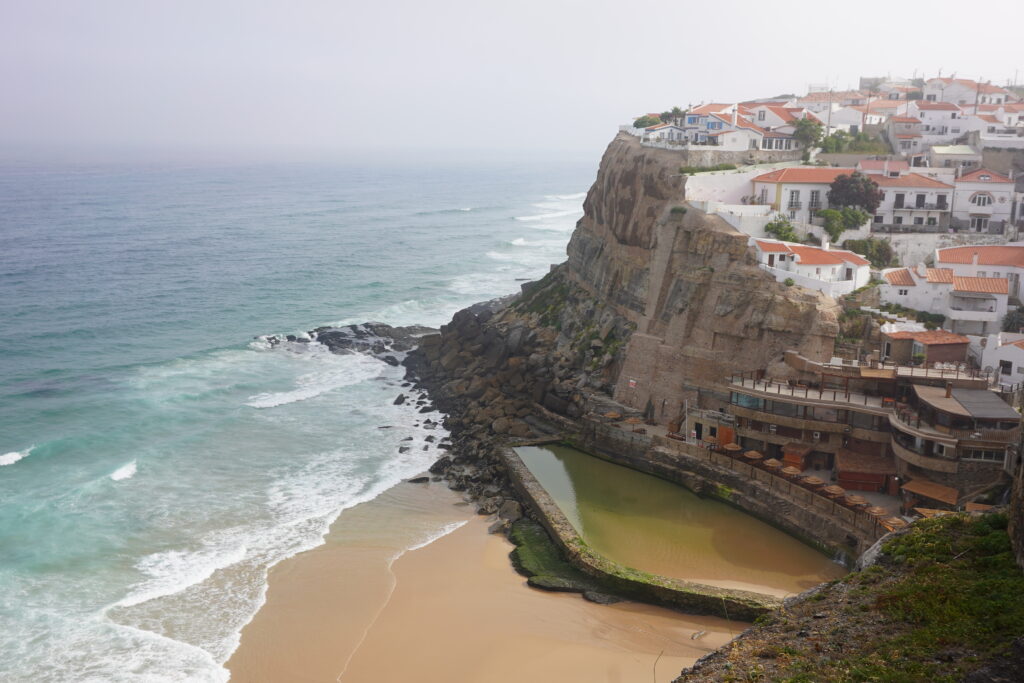
Praia da Ursa
Heading back to our second trial of seeing Cabo da Roca, we stopped to do a hike to Praia da Ursa, a wild and rugged beach that’s worth the steep trail down. The road that Google Maps indicates has a sign showing that only authorized vehicles can enter. However, to the left of the entrance to this road there is an informal parking lot where you can leave your vehicle and start the hike from there.
The hike to the beach is not long, around 1,3 km, which you can do in around 30 min if you’re reasonably fit. This hike was also steep and slippery in some areas, so make sure to bring good shoes. There were some places where you could pass through bushes, and there was even a rope to help you climb a particularly steep hill. The hike is however beautiful, and you get fantastic views of the Praia da Ursa, which has several huge rocks in the water. There’s also plenty of wildflowers, with a great diversity, which make the hike particularly colorful.
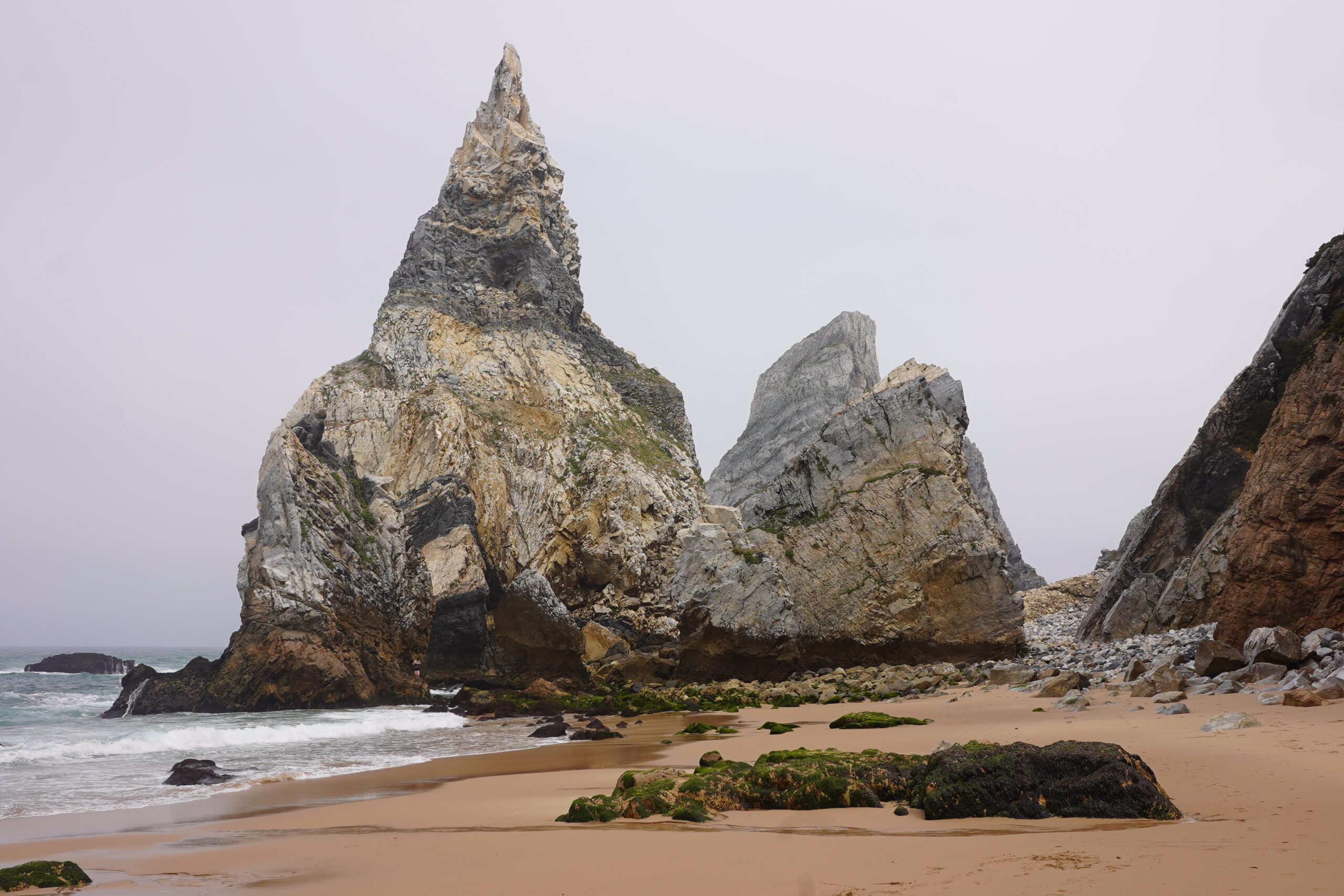
The beach itself is really beautiful too. As mentioned, there are rocks of 50-100 m tall in the water, both on the left and the right sides of the beach. While the central part is mostly sand, if you go to your left or right you will get into rocky areas, where you can hike through boulders. On the right side from the entrance there is a small waterfall, and if you continue further, you will see an arch in one of the large rocks. The path continued further, but we didn’t take it.
Cabo da Roca (again)
After climbing up from the hike, we headed back to Cabo da Roca, where you could not see fog anymore, but was also much more crowded. After seeing the Praia da Ursa, Cabo da Roca was not particularly impressive, although the part of the lighthouse surrounded by yellow wild flowers was worth the shot. There’s also facilities there, a paid bathroom and a souvenir store/restaurant.
Palácio da Pena
In the afternoon, we finally made it to Palácio da Pena, the iconic, colorful castle perched above Sintra. Yes, it’s popular and yes, it’s crowded, but it’s worth to go. The palace consists of two main areas, the old palace, painted in red, which used to be a monastery, and the new palace, painted in ochre, which was built by King consort Ferdinand II. The interior of the palace was, for me, much more interesting than the exterior. There are multiple rooms, beautifully decorated and with plenty of works of art to keep you entertained for hours. Contrary to Quinta do Regaleira, you need to arrive to the palace entrance before your entry time.

The gardens of the Palácio da Pena are nice but not spectacular. Apart from the palace, there are three more viewpoints that are recommended on the map, including the stables, a cross, and Lago. I didn’t reach the cross, and didn’t find the stables particularly exciting. The Lago part was worth a visit if you have the time and energy. It’s a water reservoir and has some towers inside of the water lake. You can have some nice photos to play with the reflections of the tower in the water.
How to get to Palácio da Pena?
You can drive there, take the bus or hike. The roads are narrow, and it’s crowded, so if you don’t like driving in these conditions, it’s better to take the bus or hike up. The hike was quite good. You can start it from the center of Sintra, where there is a label that says it takes you 64 min to the palace. As always with hiking, times differ based on your personal characteristics. I’m moderately fit and we were tight on time, so we didn’t stop on the nice photostops of the way. The hike up took us less than 40 min. If you’re not used to go continuously up, it’s too hot, and/or you want to take photos, the time approximation that they give is accurate.
If you have time to enjoy the hike, I recommend to stop at Vila Sassetti, which has pleasant gardens and a nice building. Also, in the website they mention that it takes 30 min to go from the garden entry to the palace entry. It took us 10-15 min, it’s really not such a long way but it’s going uphill. There is the possibility to take a transfer to the palace from the entrance, which is great for hot weather or if you simply don’t enjoy hiking up that much.
Day 5 – Cascais
On our last day, we made our way to Cascais, a stylish coastal town. We parked next to Boca do Inferno, some nice cliffs near the sea where the water can be aggressive, although everything was very calm when I was there.
Walk near the ocear
We wandered through Campos de Lapiás to go to the town. The Campos de Lapiás are some black and orange rocks near the coast, formed by the partial dissolution of the rocks due to the water. We then stopped at the Faro de Santa Maria, a lighthouse that was in maintenance. There is a museum of lighthouses there as well for those interested. We continued towards the Mirador de Casa Santa Maria, one of the most famous sights in Cascais. There is an area of sea that gets into the land, but is a bit more covered. Lot of people swimming there, as the water is not deep and there are no waves, so it’s perfect for keeping an eye on small kids. There were some small fish swimming, and we even saw fishermen looking for the days’ catch.
On our way to the city center, we enjoyed the Parque Marechal Carmona, where we saw several peacocks walking around and shouting, an art lesson with a live model, and a group of music practicing for a concert later in the day. We continued our cultural loop at the Fortaleza de Nossa Senhora da Luz, where you can find many small stores, and stroll around the port area. The city center has many restaurants, and we ate at Bubbles & Bites, who served excellent cod dishes. Dessert was an ice cream at Santini, a famous ice cream store in the city.

Beaches on the West
To relax before heading to the airport, we hit two final beaches: Praia da Cresmina and Praia da Arriba. Contrary to the beaches in Cascais, they had much stronger winds and thus waves, but they were also less crowded and the landscape was very enjoyable.
Getting Around Lisbon and Beyond
Navigating Lisbon and its surrounding areas is relatively straightforward, thanks to a well-connected transportation network. Here’s how you can get around:
Public Transportation
- Lisbon City: The city boasts an extensive public transport system, including metros, trams, buses, and funiculars. Consider purchasing a Lisboa Card, which offers unlimited travel on public transport and discounted entry to many attractions. Be aware of the times at which you can pick up the Lisboa Card, as it has to be from a touristic office and they usually work 10 to 19.
- Trains: For day trips to Sintra and Cascais, trains are a convenient option. The Sintra Line departs from Rossio Station, while the Cascais Line leaves from Cais do Sodré Station.
Car Rental
While public transport covers most tourist destinations, renting a car can be beneficial for exploring areas like Costa da Caparica, Sesimbra, and Cabo da Roca, where public transport options are limited.
Going from Caparica to Lisbon
The connections are not the most ideal. While I ended up using Bolt, that’s obviously not the cheapest option out there. A rental car is always helpful, but be aware that parking in the city may be complex (and not cheap), especially in high season. Public transport is also an option, but it takes much longer. An intermediate possibility is to drive from Caparica to Cacilhas and take a ferry to Cais do Sodré. The ferry takes around 30 min, and has a good frequency of 15-30 min in summer.
Accommodation Recommendations
Choosing the right place to stay can significantly enhance your travel experience. Here are the two accommodations that I used, and can totally recommend:
TRYP by Wyndham Lisboa Caparica Mar – Costa da Caparica
Located just steps from the beach, TRYP offers stunning ocean views and easy access to the coastline. The rooms are spacious and the staff was friendly and helpful. The breakfast buffet was varied and complete, with many choices of fruits, pastries, and warm foods. They also offer buffet for other meals. I took lunch one of the days, and the quality and choice of the food was good, including mussels, different types of pastas, cold salads, and multiple cakes. They also have a bar, were you can order some food, including hamburgers and salads. It’s an excellent base for exploring the beaches and enjoying the relaxed atmosphere of Costa da Caparica.
Quinta dos Lobos Boutique Hotel – Sintra
Quinta dos Lobos offered a nature experience, and they delivered. Nestled amidst lush greenery, this boutique hotel offers a tranquil retreat close to Sintra’s historic sites. The rooms were modern and comfortable, staff very helpful (they kept us informed about events and different requests through Whatsapp). The hotel’s proximity to Quinta da Regaleira makes it an ideal choice for those looking to explore Sintra’s charm while enjoying a serene environment. They also offer a parking that is included in the hotel price, and very much appreciated, because parking in Sintra is challenging. The hotel also offers a meal service, and a nice garden, where we saw a wedding party one of the days we stayed there.